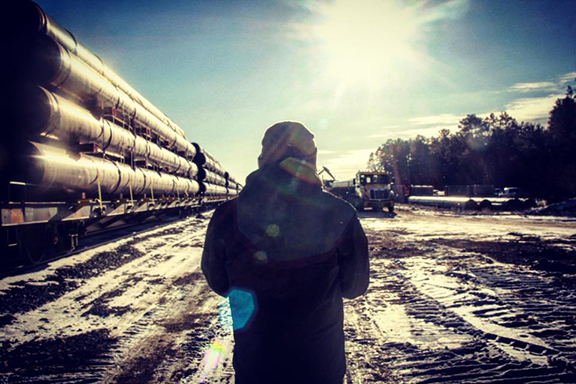By Winona LaDuke
Last month’s 383,000 gallon oil spill of the Keystone Pipeline in Edinburgh, North Dakota is the deal with the devil. For those of us who live in the land of lakes, just imagine what 383,000 gallons of oil would do to the Hay Creek, Fishhook Lake watershed, and what “clean up” would look like. There’s no way to clean up or protect that aquatic ecosystem.
There is no fish, wild rice, or life after an oil spill. That’s what a deal with the devil looks like. While Enbridge talks about the need for a new safe pipe, the Keystone pipe, now with it’s second catastrophic leak, is only l0 years old. The 2017 Keystone pipeline rupture sent 407,000 gallons spewing into South Dakota groundwater. The spill contaminated 209,000 square feet of land, and they don’t have water the way we do. This is a new pipe, less than ten years old, and what we
We really don’t need a new Line 3, Enbridge needs that pipe. What we need is to have Enbridge clean up old pipes, decommission, and begin to move towards renewable energy – be a good neighbor and all. Instead, what we have is a corporation who desperately needs this pipeline, pumping toxic money into advertising in Minnesota, promoting division in our communities, kindling racism and hatred.
Enbridge has had two pipeline projects fail, that’s the Enbridge Northern Gateway (a heavily opposed tar sands project to Pacific Ocean, intended for Chinese markets) and the Sandpiper. They just withdrew their application for their “absolutely essential” project so the company could move its interests to the Dakota Access Pipeline. Investors don’t like companies who cannot carry out projects, and Line 3 is their biggest project to date.
“Investor confidence” is a growing problem for fossil fuels companies, including Enbridge, as billions of dollars are divested from the tar sands and from fossil fuels.
I don’t really care about Enbridge’s financial stress. Nor should Minnesota. There’s no need for a tar sands pipeline to bolster ailing sales in the Canadian tar sands. Our water and our future are best with renewable energy and conservation. 383,000 gallons of oil will not help the wild rice and lakes of our wonderful Akiing, the land.
North Dakota has sold its water and soul to the oil companies. Three years ago, a study by Duke University found “Accidental wastewater spills from unconventional oil production in North Dakota … caused widespread water and soil contamination…. Researchers found high levels of contaminants and salt in surface waters polluted by the brine-laden wastewater, which primarily comes from fracked wells. Soil at spill sites was contaminated with radium. At one site, high levels of contaminants were detected in residual waters four years after the spill occurred.”
In the meantime, the Lakota are making deals with the Creator for a better future. The first solar farm in North Dakota went up this year, the Cannonball Solar Project on the Standing Rock Reservation. Born from the ashes of the Dakota Access Pipeline Battle, Standing Rock shows us all what the future looks like.
CannonBall is where the price of electricity to tribal members is at l3 cents a kilowatt hour, the highest in the state, except for the Turtle Mountain reservation, which also has this dubious honor of expensive electricity. This past summer, many veterans of the siege at Standing Rock returned, this time to celebrate a victory. Mark Ruffalo (The Avengers) and Shailene Woodley (Big Little Lies) and Rep. Tulsi Gabbard (D-Hawaii), all came to Standing Rock.
The Cannonball Community Solar Farm adds 300 kilowatts into the grid, which might not sound a lot, but it is for this community. It’s estimated the solar farm will save the community $7,000 to $10,000 annually in energy costs. This money will go back into the community, said Hayes Baynard, the CEO of GivePower, one of the nonprofits that is partnering on the project and invested $370,000 in it. The farm’s total cost was $470,000. That’s just the beginning of energy sovereignty at Standing Rock. Cody Two Bears, of Indigenized Energy and former Standing Rock tribal council member, talks about that vision.
“It’s one thing to protest about it, to talk about it, but now we got to be about it.” The solar farm connected to the grid in February, and went live in August, powering the Cannonball Youth Center and the Veterans Memorial Building where thousands of veterans who came as Water Protectors, stayed in 2016. Meanwhile, the state of North Dakota boasts no utility scale solar, and continues with immense, unrealized wind potential. Leadership comes from Native people.
It’s more than just post fossil fuels economics. It’s about the future of electrification in this country. Think of it this way, this past month, Pacific Gas and Electric, northern California’s largest northern utility, blacked out the power to 500,000 homes because of forest fires; last year’s Paradise Fire was actually caused by PGE Lines. As fires raged, fanned by climate change and poor infrastructure, there were still lights on at the Blue Lake Rancheria, a Wiyot, Yurok and Hupa village near Eureka with a megawatt of solar and a battery backup system.
Adopting a climate action plan in 2008 the tribe mobilized every resource at its disposal to advance a leading-edge strategy for eliminating its carbon footprint while bolstering climate resiliency. To date, the Tribe has reduced energy consumption by 35% and reduced greenhouse gas emissions 40%, utilizing biodiesel to power public buses and aggressive energy efficiency measures. In the Obama Administration, Blue Lake was recognized as one of 16 communities designated as White House Climate Action Champions.
The grid wis down and the tribe still has power. Now, what’s wrong with that? That’s the deal made with future generations, a deal with the Creator, not the Devil. Change comes, it’s a question of who controls the change. Looking down the barrel of a bad pipeline, I can tell you we don’t need to make that deal with the Devil. I’m going to grow my gardens with water. North Dakota and Enbridge, you all grow your food with oil. I’m going to commit to solar and renewables. Let’s see whose deal works out.







